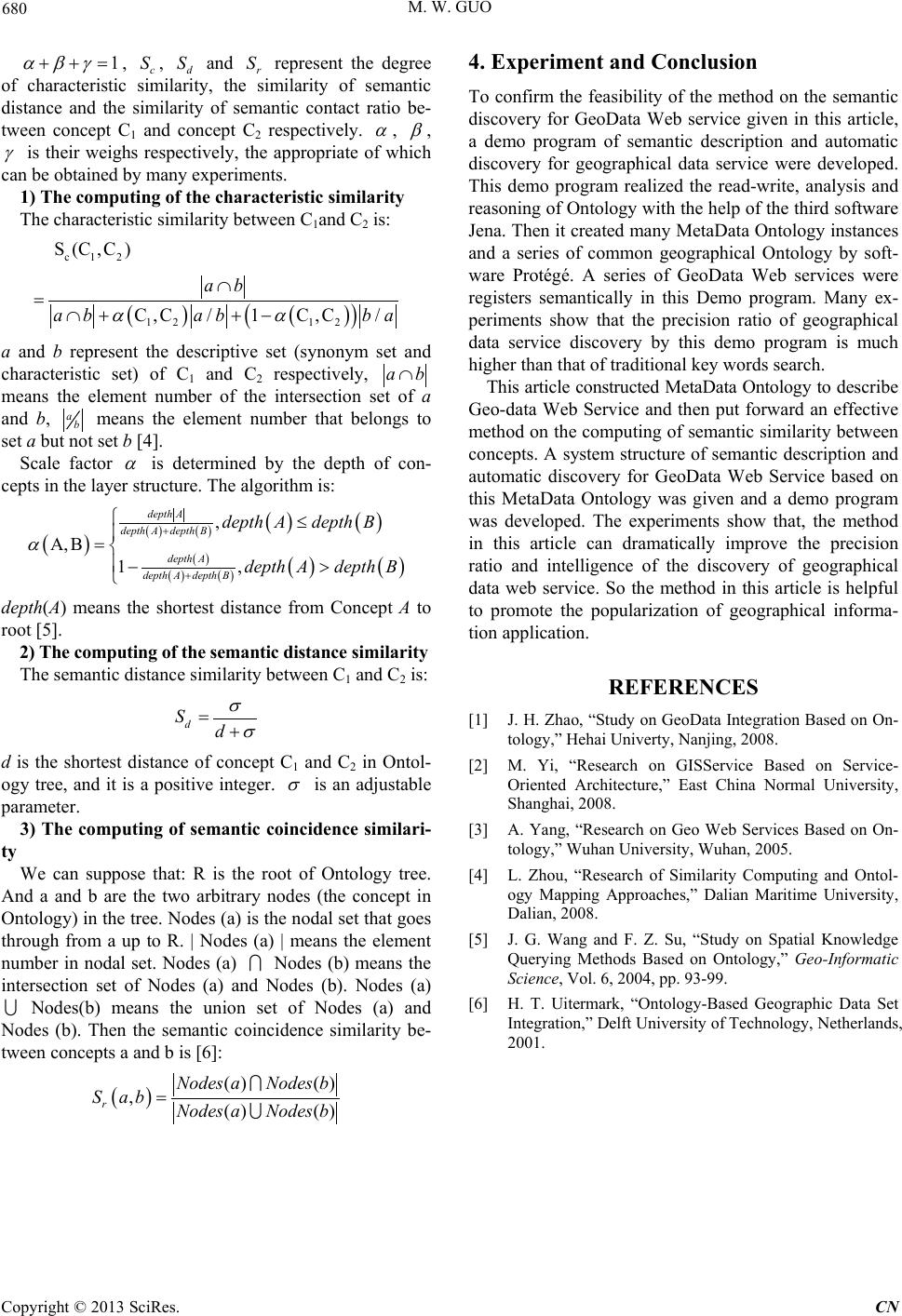
M. W. GUO
,
,
and
represent the degree
of characteristic similarity, the similarity of semantic
distance and the similarity of semantic contact ratio be-
tween concept C1 and concept C2 respectively.
,
,
is their weighs respectively, the appropriate of which
can be obtained by many expe ri ments .
1) The computing of the characteristic similarity
The characteristic similarity between C1and C2 is:
( )( )
( )
c12
12 12
S(C,C)
C ,C/1C,C/
ab
a babba
αα
∩
=∩+ +−
a and b represent the descriptive set (synonym set and
characteristic set) of C1 and C2 respectively,
means the element number of the intersection set of a
and b,
means the element number that belongs to
set a but not set b [4].
Scale factor
is determined by the depth of con-
cepts in the layer structure. The algorithm is:
( )
( )( )
( )( )
( )
( )( )
( )( )
,
,1,
depth A
depth Adepth B
depth A
depth Adepth B
depthAdepth B
depthAdepth B
α
+
+
≤
ΑΒ =
−>
depth(A) means the shortest distance from Concept A to
root [5].
2) The computing of the semantic distance similarity
The semantic distance similarity between C1 and C2 is:
d is the shortest distance of concept C1 and C2 in Ontol-
ogy tree, and it is a positive integer.
is an adjustable
parameter.
3) The computing of semantic coincidence similari-
ty We can suppose that: R is the root of Ontology tree.
And a and b are the two arbitrary nodes (the concept in
Ontology) in the tree. Nodes (a) is the nodal set that goes
through from a up to R. | Nodes (a) | means the element
number in nodal set. Nodes (a)
Nodes (b) means the
intersection set of Nodes (a) and Nodes (b). Nodes (a)
Nodes(b) means the union set of Nodes (a) and
Nodes (b). Then the semantic coincidence similarity be-
tween concepts a and b is [6]:
( )
() ()
,() ()
r
NodesaNodes b
S abNodes aNodes b
=
4. Experiment and Conclusion
To confirm the feasibility of the method on the semantic
discovery for GeoData Web service given in this article,
a demo program of semantic description and automatic
discovery for geographical data service were developed.
This demo program realized the read-write, analysis and
reasoning of Ontology with the help of the third software
Jena. Then it created many MetaData Ontology instances
and a series of common geographical Ontology by soft-
ware Protégé. A series of GeoData Web services were
registers semantically in this Demo program. Many ex-
periments show that the precision ratio of geographical
data service discovery by this demo program is much
higher than that of traditional key words search.
This article constructed MetaData Ontology to describe
Geo-data Web Service and then put forward an effective
method on the computing of semantic similarity between
concepts. A system structure of semantic description and
automatic discovery for GeoData Web Service based on
this MetaData Ontology was given and a demo program
was developed. The experiments show that, the method
in this article can dramatically improve the precision
ratio and intelligence of the discovery of geographical
data web service. So the method in this article is helpful
to promote the popularization of geographical informa-
tion application.
REFERENCES
[1] J. H. Zhao, “Study on GeoData Integration Based on On-
tology,” Hehai Univerty, Nanjing, 2008.
[2] M. Yi, “Research on GISService Based on Service-
Oriented Architecture,” East China Normal University,
Shanghai, 2008.
[3] A. Yang, “Research on Geo Web Services Based on On-
tology,” Wuhan University, Wuhan, 2005.
[4] L. Zhou, “Research of Similarity Computing and Ontol-
ogy Mapping Approaches,” Dalian Maritime University,
Dalian, 2008.
[5] J. G. Wang and F. Z. Su, “Study on Spatial Knowledge
Querying Methods Based on Ontology,” Geo-Informatic
Science, Vol. 6, 2004, pp. 93-99.
[6] H. T. Uitermark, “Ontology-Based Geographic Data Set
Integration,” Delft University of Technology, Netherlands,
2001.
Copyright © 2013 SciRes. CN